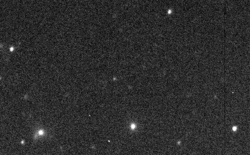Astronomy:Erriapus
 Discovery images of Erriapus taken by the CFHT in September 2000 | |
| Discovery[1] | |
|---|---|
| Discovered by | John J. Kavelaars et al. |
| Discovery date | in 2000 |
| Designations | |
Designation | Saturn XXVIII |
| Pronunciation | /ɛriˈæpəs/ |
| Named after | Erriap(p)us |
| S/2000 S 10 | |
| Orbital characteristics[2] | |
| Epoch 2000 Feb. 26.00 | |
| 17 343 000 km | |
| Eccentricity | 0.4724 |
| Orbital period | 871.2 d (2.38 yr) |
| Inclination | 34.692 |
| Satellite of | Saturn |
| Group | Gallic group |
| Physical characteristics | |
| Mean diameter | 10+50% −30% km[3] |
| Rotation period | 28.15±0.25 h[3] |
| Albedo | 0.04 (assumed)[4] |
Spectral type | light red B−V=0.83, R−V=0.49[5] |
Erriapus /ɛriˈæpəs/, or Saturn XXVIII (28), is a prograde irregular satellite of Saturn. It was discovered by Brett Gladman, John J. Kavelaars and colleagues in 2000, and given the temporary designation S/2000 S 10.[6][7] It was named Erriapo in August 2003[8] after Erriapus (also rendered Erriappus), a giant in Gaulish mythology; the name was changed from dative Erriapo to nominative Erriapus per IAU conventions in late 2007.[9][10]
Erriapus is about 10 kilometres in diameter, and orbits Saturn at an average distance of 17.3 Gm in 871 days.
As a member of the Gallic group of irregular satellites, which share similar orbital characteristics and a light-red colour, Erriapus is hypothesized to have its origin in the break-up of a common progenitor of the group,[5][11] or to be a fragment of its largest member, Albiorix.[12] With a rotation period of 28.15±0.25 h and an elongated shape, it is a candidate for a contact binary or binary moon.[13]
References
- ↑ Discovery Circumstances (JPL)
- ↑ Mean orbital parameters from JPL
- ↑ 3.0 3.1 Denk, T.; Mottola, S. (2019). "Cassini Observations of Saturn's Irregular Moons". 50th Lunar and Planetary Science Conference. Lunar and Planetary Institute. https://www.hou.usra.edu/meetings/lpsc2019/pdf/2654.pdf.
- ↑ Scott Sheppard pages
- ↑ 5.0 5.1 Grav, T.; Holman, M. J.; Gladman, B. J.; Aksnes, K.; Photometric survey of the irregular satellites, Icarus, 166 (2003), pp. 33–45
- ↑ IAUC 7539: S/2000 S 10 December 7, 2000 (discovery)
- ↑ MPEC 2000-Y14: S/2000 S 3, S/2000 S 4, S/2000 S 5, S/2000 S 6, S/2000 S 10 December 19, 2000 (discovery and ephemeris)
- ↑ IAUC 8177: Satellites of Jupiter, Saturn, Uranus August 8, 2003 (naming the moon)
- ↑ "USGS: Spelling of Saturn XXVIII". https://astrogeology.usgs.gov/HotTopics/index.php?%2Farchives%2F315-Spelling-of-Saturn-XXVIII.html.
- ↑ IAUC 9191: SATURN XXVIII (ERRIAPUS) January 11, 2011
- ↑ Gladman, B. J.; Nicholson, P. D.; Burns, J. A.; Kavelaars, J. J.; Marsden, B. G.; Holman, M. J.; Grav, T.; Hergenrother, C. W.; Petit, J.-M.; Jacobson, R. A.; and Gray, W. J.; Discovery of 12 satellites of Saturn exhibiting orbital clustering, Nature, 412 (July 12, 2001), pp. 163–166
- ↑ Grav, T.; and Bauer, J.; A deeper look at the colors of Saturnian irregular satellites
- ↑ Denk, T.; Mottola, S.; Bottke, W. F.; Hamilton, D. P. (2018). "The Irregular Satellites of Saturn". Enceladus and the Icy Moons of Saturn. 322. University of Arizona Press. pp. 409–434. doi:10.2458/azu_uapress_9780816537075-ch020. ISBN 9780816537488. Bibcode: 2018eims.book..409D. https://tilmanndenk.de/wp-content/uploads/DenkEtAl2018_IrregularMoons.pdf.
- Ephemeris from IAU-MPC NSES
External links
 |


